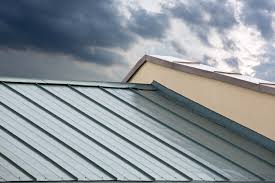A Guide to Selecting the Right Metal Roof
Panel
With the great variety on the market, one
of the main questions we, as metal roof panel manufacturers, get from customers
is “How do I select the right panel for my project?” The answer can generally
be found by examining a number of criteria, including the properties of the
roof, the region and climate, geometry, slope, warranty type…among other key
factors.
Slope— Slope is the first consideration as
just this one aspect will eliminate certain panels, making it easier to narrow
down options right from the start. The two types of roof slopes are low slope
and steep slope.
A low-slope roof, commonly found in
commercial applications, is one whose slope is less than 3:12. The benefits
include a simpler geometry that is often much less expensive to construct, and
the requirement of fewer materials than a steep slope, thereby reducing
material costs.
A steep slope roof, more common in
residential construction, is one whose slope is greater than 3:12. Steeper slopes
are ideal for areas that have higher snow loads and will also prevent the
possibility of ponding water on the roof. Since the roof is a visible part of
the structure, choosing a metal roof for residential construction often skews
more toward aesthetic considerations.
Location/Climate— The location and climate
of the project is a factor, specifically when looking at
certifications/regulatory product approvals, which will limit the panels you
can you use within specific regions. This is most relevant to Dade County, the
state of Florida, and the Texas Coast, as well as certain snow regions.

How to Choose a Metal Roof
Metal can be formed into a variety of
roofing materials, including these stone-coated steel shingles from Boral.
Metal’s market share is on the rise, now accounting for about 14% of the total
residential re-roofing market.
Metal roofing has a long history in the
U.S. but until 20 years ago it was a bit player in residential construction
with just a 3.6% share of the reroofing market. That number has roughly
quadrupled since then, according to an industry trade group, as metal claims an
increasingly larger slice of the pie
What happened? Product offerings are more
extensive than the simple corrugated panels that have long been used on barns
and sheds. Metal roofing is available in a range of styles — from several kinds
of standing seam to a variety of stamped metal shingles that look like slate,
clay tile, and even asphalt. Paint and stone coatings are more sophisticated
and more durable, giving roofing a very long service life while appealing to
homeowners with a variety of aesthetic preferences.
The industry also is working harder to win
over consumers who once thought that metal roofing was too hot, too heavy,
noisy, or prone to rust, says Dick Bus, president of ATAS International and
head of the Metal Roofing Alliance. “Those myths are gone, and people want to
reroof with something that has some permanence to it,” he said. “Metal roofing
that’s properly installed can last upwards of 50 to 60 years or more.”
Metal roofing may never catch up to asphalt
in the residential arena simply because of cost. Light gauge, through-fastened
panels might be competitive with asphalt on a simple roof shape, but the
industry acknowledges that a standing seam or metal shingle roof can be two or
three times the initial cost of asphalt. Still, manufacturers think they can
continue expanding on the strength of other attributes: long-term performance,
recyclability, high fire resistance, and low maintenance.

CHOOSING A METAL ROOF – FIVE MISTAKES YOU
MUST AVOID
Unless you’re involved in the roofing or
construction business or you’re one of the few outside the industry that have
purchased more than one metal roof, it’s likely that your initial investigation
into the topic leaves you bewildered at the great variety of choices. We
routinely get emails and contact forms with questions in the comment section
asking, “How much for a metal roof?” Unfortunately, that’s a little
like asking, “How much for a new car?” The answer to both variable –
what are you looking for? We supply metal roofing that costs anywhere from $1 a
square foot to over $20 – and in every case it’s fair to say, “You get
what you pay for!” The reason for the tremendous range is that there literally
hundreds of choices that are all “metal roofs.”
Assume all metal roofs are the same.
They are NOT. They vary by metal type,
thickness of metal, finish, and profile. Metal roofs come in more shapes,
sizes, types, finishes, thicknesses, and those differences can affect
performance, lifespan, durability and price
Assume all roofers know about metal
roofing.
This is simply not true. While most roofers
and roof contractors claim to be able to install ANY roof – including metal –
the fact of the matter is that most of them don’t have much experience with
metal roofing systems. Since composition shingles are the most common roofing
material by a wide margin (no coincidence they’re the cheapest by a wide
margin!), that is the product with which most roofers are experienced. I can
tell you from many years of first-hand experience with the finished jobs that
there is a GREAT difference between the finished job of an experienced and
properly trained metal roof specialist and that of the average “roofer.”
If you’re going to hire someone to install your carefully selected roof, make
every effort to make certain that they have years of sheet metal practical
experience. You’ll be sorry if you don’t.
Buy the wrong metal roof for your
application.
As good as metal roofs can be, they must be
matched to the job. For example, while metal roofs can be excellent in snow
country, the wrong metal roof can “hook” moving snow and ice and
cause damage, while a properly chosen and executed metal roof will shed snow
and ice without damage. Similarly, there are many metal roof materials that
work well in locations near salt water, but choosing the wrong base metal and
premature orrosion can result, dramatically reducing the life span of the roof.
Buy a metal roof based on price alone.
Just as you wouldn’t buy a car (or house or
television or refrigerator, etc., etc.) on price
alone, the same applies to metal roofing
materials. There’s a reason one metal roof is cheaper than another, and it’s
usually because the material is thinner, the metal is cheaper (and less
corrosion resistant), the finish is poor or the profile is weak. To ensure you
get good value for the money you’re spending, make sure you’re spending enough
to get a metal roof that will do the job you’re expecting.

Key Considerations for Selecting the Right
Metal Roof
Selecting the right metal roof for your
home can be a challenge. Once you’ve decided on metal for protecting your home,
there are still many decisions ahead about which products will best meet the
demands of our local climate, look great, and be the easiest to maintain
Industry-leading PVDF coating technology.
Many people choose metal roofs in order to avoid the streaking and staining
that attacks granulated-surface shingles. Kynar 500® and Hylar 5000® PVDF
resin-based finishes offer the best resistance to streaking and staining. These
finishes are available in many colors and even multi-hued shades, offering the
best combination of durability and fade resistance.
“Self-Cleaning” Valleys. Let’s face it, a
lot of debris ends up on your roof; tree leaves, pine needles, seed pods, ice,
and snow. They all travel down your roof and end up in any valleys the roof may
have. Many metal roofs have “closed” valley systems with hidden waterways to
channel water off of the roof. These hidden waterways, however, will clog up
with debris and then the water path is blocked and bad things (leaks!) happen.
“Self-Cleaning” valleys carry the water and debris on top of the roof and can’t
clog.
Premium Certified Products. The Metal
Construction Association has developed a Quality Certification Program which
recognizes products and manufacturers that meet high levels of standards in
terms of raw materials and processes. We strongly encourage products and
manufacturers that are part of this program. Kassel and Irons products all meet
this certification.
Special Flashings. Many roofs have areas
which require special care, including special flashings. Unlike temporary
roofing solutions, you can’t just depend upon sealants for metal roofing. If
your roof has dead valleys, skylights, chimneys, flared gables, or other
unusual things, make sure that you understand exactly how these will be handled
by your contractor.

Key Considerations for Choosing a Metal
Roofing Supplier
As a manufacturer of specialty residential
metal roofing, we’d love to have the opportunity to work hard for your
confidence. However, whether you consider us or not, we want to share with you
the key things to consider when choosing a metal roofing supplier
Types and Styles of Metal Roofing
As you research metal roofing suppliers, it
will not be unusual to find that different suppliers focus on providing
different types of metal roofing. A common distinction is whether they focus on
vertical seam metal roofing or modular panel metal roofs that look like wood
shakes, slate, tile, or other materials. However, amongst the vertical seam
products, you will find further differentiation with manufacturers producing
exposed fastener products, nail hem panels, true clip-fastened standing seam
panels, and mechanically-seamed standing seam panels. Amongst the modular panel
manufacturers, you will find companies specializing in painted products,
usually using the industry-leading PVDF technology, and stone-coated products.
As you start to zero in on the style of metal roof that best meets your needs
and the architectural design of your home, we suggest choosing a supplier and
manufacturer that has significant experience with your preferred style of metal
roofing.
Taking into account the “ship-to” location
of your new roof is important. Here’s why:
If the choice for your home is a vertical
seam roof, the panels will likely be ordered in custom lengths sized from the
bottom of the roof to the peak. On many homes, these panels can be from 15 –
30’ in length or even longer. Shipping these panels over long distances can be
quite costly. While shipping a long distance may be necessary for Premium Grade
panels, lower grade panels are produced regionally and may only need to be
shipped 50 miles or less depending on where you live. The required shipping
distance will impact your cost as well as the embedded energy in your roof’s
environmental footprint.
Experience
The experience level of your metal roofing
supplier is very important. There are things that companies learn to do better
over the years, especially in the areas of flashing design and installation
details, that impact a roof’s long-term performance. Additionally, your metal
roofing manufacturer will provide the product warranty for your roof and you
will want to seek a manufacturer with proven history and stability that
indicates their ability to support any future warranty claims. You will also
find that the more experienced and stable manufacturers will usually play
industry leadership roles with highly educational websites and active
participation in industry trade associations such as the Metal Construction
Association and the Metal Roofing Alliance.
Raw Materials
Be certain to confirm the quality and grade
of metals and coatings used by the manufacturers and suppliers you are
considering. Many manufacturers are using non-North American metals for their
roofing systems as these metals are less expensive. If buying a roof made from
USA-produced raw materials is important to you, you can seek out companies that
produce their products only from domestic raw materials. An additional way to
determine raw material quality is by seeking out suppliers that meet or exceed
Metal Construction Association’s Certified Metal Roofing program requirements.